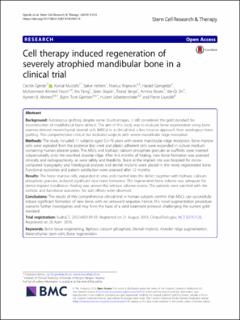Cell therapy induced regeneration of severely atrophied mandibular bone in a clinical trial
Gjerde, Cecilie Gudveig; Mustafa, Kamal Babikeir Eln; Hellem, Sølve; Rojewski, Markus; Gjengedal, Harald; Yassin, Mohammed Ahmed Alamin Yousif; Feng, Xin; Skaale, Siren G; Berge, Trond Inge; Rosén, Annika; Shi, Xieqi; Ahmed, Aymen B; Gjertsen, Bjørn Tore; Schrezenmeier, Hubert; Layrolle, Pierre
Journal article, Peer reviewed
Published version

Åpne
Permanent lenke
https://hdl.handle.net/11250/2739256Utgivelsesdato
2018Metadata
Vis full innførselSamlinger
Sammendrag
Background
Autologous grafting, despite some disadvantages, is still considered the gold standard for reconstruction of maxillofacial bone defects. The aim of this study was to evaluate bone regeneration using bone marrow-derived mesenchymal stromal cells (MSCs) in a clinical trial, a less invasive approach than autologous bone grafting. This comprehensive clinical trial included subjects with severe mandibular ridge resorption.
Methods
The study included 11 subjects aged 52–79 years with severe mandibular ridge resorption. Bone marrow cells were aspirated from the posterior iliac crest and plastic adherent cells were expanded in culture medium containing human platelet lysate. The MSCs and biphasic calcium phosphate granules as scaffolds were inserted subperiosteally onto the resorbed alveolar ridge. After 4–6 months of healing, new bone formation was assessed clinically and radiographically, as were safety and feasibility. Bone at the implant site was biopsied for micro-computed topography and histological analyses and dental implants were placed in the newly regenerated bone. Functional outcomes and patient satisfaction were assessed after 12 months.
Results
The bone marrow cells, expanded in vitro and inserted into the defect together with biphasic calcium phosphate granules, induced significant new bone formation. The regenerated bone volume was adequate for dental implant installation. Healing was uneventful, without adverse events. The patients were satisfied with the esthetic and functional outcomes. No side effects were observed.
Conclusions
The results of this comprehensive clinical trial in human subjects confirm that MSCs can successfully induce significant formation of new bone, with no untoward sequelae. Hence, this novel augmentation procedure warrants further investigation and may form the basis of a valid treatment protocol, challenging the current gold standard.
